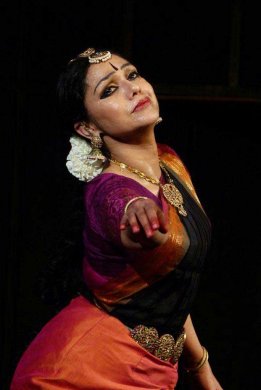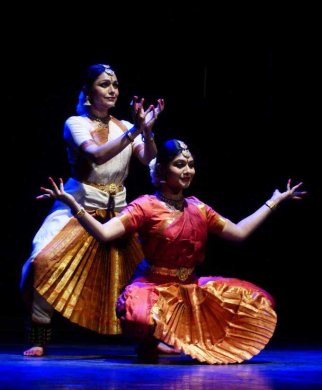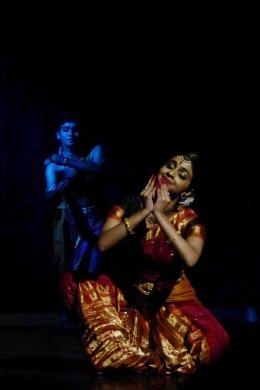
|   |

|   |
 e-mail: sunilkothari1933@gmail.com Rachana Yadav's Trishanku and Rama's tribute to her mother April 6, 2017 Rachana Yadav received training in Kathak under Guru Ravi Jain and later on worked with Aditi Mangaldas, receiving further training under her as a member of Aditi's Drishtikon Dance Foundation, performing in the company for more than a decade. She also received training under Jaikishan Maharaj, son of Birju Maharaj, in Lucknow gharana. She has established Rachana Yadav Kathak Studio and has a troupe with which she has been presenting her own choreographic works. She is the daughter of the celebrated Hindi authors Mannu Bhandari and Rajendra Yadav. Rachana also writes in Hindi and for the choreographic work Trishanku under review, she has written the four sections of poems, inspired from her mother's story of the same title. The work was presented on 1st April at Kamani Auditorium in Delhi. In her choreographer's note, Rachana mentions that she picks up subjects for her choreographies from her own life experiences. When she feels that she can express the chosen subject through dance, then only she undertakes choreographing it. The theme she chose for Trishanku is her own journey being a daughter of her mother, and herself becoming mother of her own daughter. This journey she further explains has been full of innumerable conflicts and contradictions. The problem she has posed is about how much to break from the past, how much to take from the future, and is there a perfect balance? Choreographing such a theme without a specific story line and through abstraction is a big challenge. She mentions: Is there a perfect balance point between the two opposites? Or are we in constant state of conflict between one and the other? Her poem mentions about the directions, which offer protection as well as tie her down. The loose translation of her Hindi poem I am attempting here in order to comprehend the content. It further refers to storms which obliterated the boundaries and also freed her from ties. "There was none to help for learning and leading life, nor did someone teach, to move on freely. But when those winds became storms and crossed boundaries of my freedom I did not know how to stop this force, and where do I draw limit, as I had been freed from that past and now where and how do I seek it again?" Rachana had commissioned the renowned Dhrupad singers Gundecha Brothers to compose music for some part of the choreography. Earlier they have worked with Astad Deboo, Chandralekha, and Kumudini Lakhia and have competence to compose music that fits in the dancer's concept. The other musician is Samiullah Khan. The vocals for Dhrupad singing is by Sanjeev Jha and Manish Kumar, and rest by Samiullah Khan. Pakhavaj by Mahaveer Gangani, tabla by Yogesh Gangani, sitar by Uma Shankar, sarangi by Kamaal Ahmed, flute by Kiran Kumar, mridangam and ghatam by Keshavan, other percussion and effects by Gangan Singh, and guitar by Adnan and Farhan. The music was recorded. Lighting was by Govind Yadav and costumes by Rachana Yadav. The music as an important part of production has been well composed and remains pleasant throughout. In earlier part, Dhrupad singing was resounding and dance choreography looked well conceived. Dancer forming various patterns, drawing two parallel rows, placing arms on shoulders of other dancers, turning gracefully, at times sitting and then getting up, all in perfect rhythm and laya. The poem was spoken between various phrases of group choreography and Rachana in her solos, interrogating the questions. The group performed continuously taking innumerable chakkars and executing footwork, often exiting across the stage going into the wings and then re-emerging. In her solo Rachana used kavit and song about nayika decorating herself, suggesting a happy stage of life. The Kathak technique was used skillfully in solo to depict the mood. However, to suggest the storm and conflict, with spoken text the group moved for too long duration in Kathak phrases, using all possible variations, clappings, keeping tala, rhythm and were dressed in colourful costumes. Two male dancers Ashish Kathak and Rohit Pawar trained respectively by Rajendra Gangani and Vaswati Mishra acquitted themselves well with spins and pirouettes. The female dancers too displayed technical aspects well. However, the excessive abstract dance, with repetitive footwork and chakkars began to drain dancers of energy. The continuous dancing without any pause looked interminable and one wished there were some pauses. When dancers stood at some point the audience could clap. I have been noticing in group choreography certain restlessness, continuous footwork and endless chakkars. There does not seem to be sukun, a word difficult to translate, a certain feeling of peace, quiet, feeling of shanti. Rachana would do well to resolve this problem. To suggest storm and conflict, to a point, the footwork and chakkars, in drut gati, meet the requirements of the theme. But an overall impression, with use of Kathak in this manner, does not result in rasanubhava. The relish has to be the aim. And if within an hour it is not realized then to that extent the aim is defeated. Of late I have been noticing this trend in choreographies of many dancers. Kathak, at this rate seems to be facing a crisis. The taste of public depends upon what a Kathak dancer offers. They need to elevate the audience to a level of enjoyment. Not mere bravura and speed. The excessive speed leaves connoisseurs of Kathak disappointed. With all the advantages Rachana Yadav has, she would do well to reflect upon these observations. The recitation of spoken poetry often gets drowned in the loud music. While doing recording it needs to be taken care of. If the spoken word has to communicate anything, they have to be intelligible. Abstract movements, then linked in passages, would help audience understand the intent of the choreographer. Tribute by Rama Vaidyanathan to her mother Madhavi Gopalakrishnan Photos: Avinash Pasricha Sarvam Foundation presented at Habitat Centre, Delhi, the inaugural event of Madhavi, a dance festival in honour of late Madhavi Gopalakrishnan, the mother of Bharatanatyam exponent Rama Vaidyanathan, on 3rd April. Madhavi Gopalakrishnan was a connoisseur of classical music and dance. For Rama she was a constant source of inspiration and stood by her till she breathed her last, always encouraging Rama to scale greater artistic heights. She passed away last year. In order to perpetuate her memory, her belief, love for life, its continuity and celebration, Rama planned an annual festival with help of Sarvam Foundation, several well wishers, and her own two sisters Indira Nayar and Meera Khanna. Rama presented a well conceived program by her disciples including her daughter Dakshina. Nehha Bhatnagar, disciple of Saroja Vaidyanathan and Rama, is founder president of Sarvam Foundation and took care of various other requirements.  Rama Vaidyanathan  Rama and Dakshina Vaidyanathan The very first number, choreographed by Rama was on Lakshmi and Saraswati, the goddess of prosperity and the goddess of knowledge. After Pushpanjali in raga Rasikapriya and tisra triputa tala composed by Vidya Srinivasan, the duet by Rama and Dakshina was imaginatively cast in mould of Alarippu in Sankeernam composed by Ramamoorthy Sriganesh. It was fascinating to see the chemistry between mother and daughter. Dakshina has blossomed into a versatile dancer under the watchful guidance of her grandmother Saroja Vaidyanathan and mother Rama. Their synchronization of movements was perfect. Like two well tuned veenas they responded to each other. But the most impressive was the concept of alarippu, Rama as Saraswati holding veena and Dakshina, as Lakshmi, suggesting wealth and dancing to the mnemonics of alarippu, with excellent musical score by Sudha Raghuraman (vocal), Dr S. Vasudevan (nattuvangam), Sumod Sridhar (mridangam) and G.Raghuraman (flute). It was a sheer pleasure to watch both perform with complete command over movements and tala. Rama deserves congratulations for exploring alarippu. This work adds to her earlier choreography of Mayura Alarippu which one remembers for novel exploration of holding mayura hasta mudra and dance suggesting the joyous dance of a peacock! Rama's disciple Kavya Ganesh performed Ardhanareeswara ashtakam, verses by Adi Sankaracharya in raga Megh and tala adi, composed by O.S Arun. Taking the shloka of Kalidasa comparing Shiva and Parvati as vak, speech and artha, meaning, together, the choreography explored the half male and half female aspects of the Lord. Sankaracharya's verses describing various attributes, ornaments were enacted by Kavya distinctly showing tandava element and lasya element for Shiva and Parvati. The energetic execution in keeping with excellent mridangam accompaniment by Sumod Sridhar was enchanting. Kavya performed with total involvement. Offering an ode to the tree that gives us life's lessons, a poem which Rama has written and translated by Shatavadhani Ganesh, saw Dakshina in her element. Set to raga Hamir Kalyani and adi tala, music composed by Sudha Raghuraman, the piece describes the glory of a tree. The various movements suggesting the creepers, flowering of the tree, and gentle swaying of the branches, were aesthetic and suited the theme. I had seen Rama performing this number at the Music Academy Dance Festival and its presentation by Dakshina further enhanced the feeling of joyous abandon and message on why we need to preserve environment and trees. Another promising disciple of Rama, Shubha Mani performed 'Lament to birds' - a nayika's confession of her love for Vishnu to the birds. Music for it was composed by G.S. Rajan, set to Ragamalika and adi tala to the verses from Divyaprabandham. It offered enough scope to the dancer to weave in ways of flying of the birds and conversing with them. In the finale the majestic vehicle of Lord Vishnu spreading its wings and with exquisite gait of a royal vehicle the dancer created a beautiful visual. One saw birds chirping, flying and nayika engaging herself in pleasant talks.  Himanshu & Nehha
Vallabhacharya's Madhurashtakam is a favourite composition for dancers.
Rama choreographed it as a duet with Himanshu Srivastava as Lord Krishna
and Nehha as gopi describing the sweetness of the persona of Krishna,
be it his gentle smile, his face, his talk, his gait and so on. Set to
Ragamalika and adi tala, both acquitted themselves well performing in
unison. Nehha has a mobile visage and registers expressions with ease.
Himanshu when narrating the beauty and sweetness danced with abandon and
took various attractive poses when standing at the back as Nehha
described the wonderful garlands Krishna wore. It was quite a clever
ploy to have one describing and the other at the back suggesting
relevant aspect of sweetness.For finale, Rama chose the theme of ten stages of human life, inspired from the Granth Sahib. The verses were translated by Divyanand Jha. This offered scope to Dr. S. Vasudevan and K.V. Venkateswaran to compose the appropriate music set to Ragamalika and adi tala, for each stage of life. Singer Sudha Raghuraman was in her element. Rama with her command over abhinaya communicated with ease each stage from birth to final death. With imaginative choreography, she displayed each stage from childhood, youth, seeking money, wealth, in later years wanting peace and the end of journey. The philosophy was envisioned through dance in engaging manner to which audience responded. Handling such a theme Rama showed that in Bharatanatyam there is scope to explore various aspects of life. The nritta passages were varied and embellished the overall impact. This is a fine phase in Rama's career with a team of musicians who work together creating gems of dance choreographic works. The tribute to her mother Madhavi by Rama was a moving and rewarding experience.  Dr. Sunil Kothari is a dance historian, scholar, author and critic. He is honored with Padma Shri, Sangeet Natak Akademi award and Senior Critic Award from Dance Critics Association, NYC. Post your comments Please provide your name and email id when you use the Anonymous profile in the blog to post a comment. All appropriate comments posted with name & email id in the blog will also be featured in the site. |